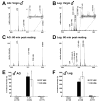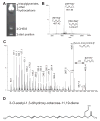A new male sex pheromone and novel cuticular cues for chemical communication in Drosophila
- PMID: 19615904
- PMCID: PMC2726907
- DOI: 10.1016/j.cub.2009.06.037
A new male sex pheromone and novel cuticular cues for chemical communication in Drosophila
Abstract
Background: In many insect species, cuticular hydrocarbons serve as pheromones that can mediate complex social behaviors. In Drosophila melanogaster, several hydrocarbons including the male sex pheromone 11-cis-vaccenyl acetate (cVA) and female-specific 7,11-dienes influence courtship behavior and can function as cues for short-term memory associated with the mating experience. Behavioral and physiological studies suggest that other unidentified chemical communication cues are likely to exist. To more fully characterize the hydrocarbon profile of the D. melanogaster cuticle, we applied direct ultraviolet laser desorption/ionization orthogonal time-of-flight mass spectrometry (UV-LDI-o-TOF MS) and analyzed the surface of intact fruit flies at a spatial resolution of approximately 200 mum.
Results: We report the chemical and spatial characterization of 28 species of cuticular hydrocarbons, including a new major class of oxygen-containing compounds. Via UV-LDI MS, pheromones previously shown to be expressed exclusively by one sex, e.g., cVA, 7,11-heptacosadiene, and 7,11-nonacosadiene, appear to be found on both male and female flies. In males, cVA colocalizes at the tip of the ejaculatory bulb with a second acetylated hydrocarbon named CH503. We describe the chemical structure of CH503 as 3-O-acetyl-1,3-dihydroxy-octacosa-11,19-diene and demonstrate a behavioral role for this compound as a long-lived inhibitor of male courtship. Like cVA, CH503 is transferred from males to females during mating. Unlike cVA, CH503 remains on the surface of females for at least 10 days.
Conclusions: Oxygenated hydrocarbons comprise a major previously undescribed class of compounds on the Drosophila cuticular surface. A newly discovered long-chain acetate, CH503, serves as a mediator of courtship-related chemical communication.
Figures





Similar articles
-
Replenishment of Drosophila Male Pheromone After Mating.J Chem Ecol. 2024 Apr;50(3-4):100-109. doi: 10.1007/s10886-023-01468-5. Epub 2024 Jan 25. J Chem Ecol. 2024. PMID: 38270733
-
Ontogeny of Drosophila melanogaster female sex-appeal and cuticular hydrocarbons.Integr Zool. 2010 Sep;5(3):272-82. doi: 10.1111/j.1749-4877.2010.00213.x. Integr Zool. 2010. PMID: 21392345
-
Variation in the male pheromones and mating success of wild caught Drosophila melanogaster.PLoS One. 2011;6(8):e23645. doi: 10.1371/journal.pone.0023645. Epub 2011 Aug 17. PLoS One. 2011. PMID: 21858189 Free PMC article.
-
Chemical Cues that Guide Female Reproduction in Drosophila melanogaster.J Chem Ecol. 2018 Sep;44(9):750-769. doi: 10.1007/s10886-018-0947-z. Epub 2018 Mar 19. J Chem Ecol. 2018. PMID: 29557077 Free PMC article. Review.
-
Chemical signalling: laser on the fly reveals a new male-specific pheromone.Curr Biol. 2009 Aug 11;19(15):R653-5. doi: 10.1016/j.cub.2009.06.051. Curr Biol. 2009. PMID: 19674549 Review.
Cited by
-
Pheromones mediating copulation and attraction in Drosophila.Proc Natl Acad Sci U S A. 2015 May 26;112(21):E2829-35. doi: 10.1073/pnas.1504527112. Epub 2015 May 11. Proc Natl Acad Sci U S A. 2015. PMID: 25964351 Free PMC article.
-
Male-specific transfer and fine scale spatial differences of newly identified cuticular hydrocarbons and triacylglycerides in a Drosophila species pair.PLoS One. 2011 Feb 14;6(2):e16898. doi: 10.1371/journal.pone.0016898. PLoS One. 2011. PMID: 21369358 Free PMC article.
-
Hierarchical chemosensory regulation of male-male social interactions in Drosophila.Nat Neurosci. 2011 Jun;14(6):757-62. doi: 10.1038/nn.2800. Epub 2011 Apr 24. Nat Neurosci. 2011. PMID: 21516101 Free PMC article.
-
Dietary effects on cuticular hydrocarbons and sexual attractiveness in Drosophila.PLoS One. 2012;7(12):e49799. doi: 10.1371/journal.pone.0049799. Epub 2012 Dec 5. PLoS One. 2012. PMID: 23227150 Free PMC article.
-
Live Drosophila melanogaster Larvae Deter Oviposition by Drosophila suzukii.Insects. 2022 Jul 29;13(8):688. doi: 10.3390/insects13080688. Insects. 2022. PMID: 36005313 Free PMC article.
References
-
- Howard RW, Blomquist GJ. Ecological, behavioral, and biochemical aspects of insect hydrocarbons. Annu Rev Entomol. 2005;50:371–393. - PubMed
-
- Bray S, Amrein H. A putative Drosophila pheromone receptor expressed in male-specific taste neurons is required for efficient courtship. Neuron. 2003;39:1019–1029. - PubMed
-
- Greenspan RJ, Ferveur JF. Courtship in Drosophila. Annu Rev Genet. 2000;34:205–232. - PubMed
-
- Hall JC. The mating of a fly. Science. 1994;264:1702–1714. - PubMed
Publication types
MeSH terms
Substances
Grants and funding
LinkOut - more resources
Full Text Sources
Molecular Biology Databases

